 |  |
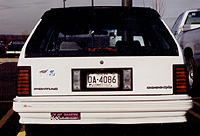 1988 saw a return to white on blue - making the plates the same colors as regular passenger car plates once again. Several key differences remained, though - there was no dot separator between the letters and numbers, and the little map graphic did not appear on these plates. 1988 saw a return to white on blue - making the plates the same colors as regular passenger car plates once again. Several key differences remained, though - there was no dot separator between the letters and numbers, and the little map graphic did not appear on these plates.
Starting in 1992, Dealer plates became 2-year registrations. Regular passenger-car style decals came into use on these plates, with 1994 expirations.
In 1996, everything old became new again - Used Dealer plates once again carried embossed expiration dates beginning with 98 (this time with the month as well). Colors reversed yet again to blue on white. These plates were used for two years, and a dot was introduced between the letters and numbers. Also at this time, larger dealerships began to receive plates with three prefix letters - i.e., after reaching 'DY-', a plate with 'DAA-' was issued, followed by 'DBA-' and so on. Used car dealerships this large are not common, and thus neither are Used Dealer plates with 3-letter prefixes.
For the 2000 and 2001 expirations, the lettering was changed to black, and the little map graphic was added to the plates - located next to the word "Connecticut" - which is at the bottom of Dealer plates. Colors of the numbers/lettering has changed every two years since.
With the general reissue taking place starting in 2000, Used Dealer plates were changed as well. New narrower (and harder to read) dies were used. The background became a fully-reflectorized silver-grey.
Colors continue to change every two years. 2010 and 2011 are back to black lettering - same as was done 10 years earlier for 2000 and 2001. 2012 and 2013 are green on silver, 2014 and 2015 are maroon on silver. The 2016 expirations, issued starting in 2014, are light blue on silver. Perhaps this was to celebrate the 40th anniversary of the Polyvend plates used in the 1970s, as the colors are similar.
Dealer and Repair plates can now be seen with a letter suffix, e.g. D-123B instead of DB-123. It appears that these may be replacement plates for lost or damaged ones.
|
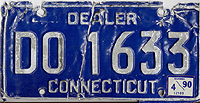 |
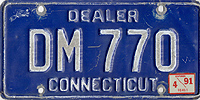 |
1990
Miserable shape, but it'll have to do until I find a better one. |
1991 |
| |
|
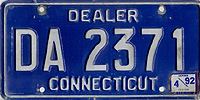 |
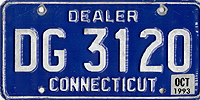 |
| 1992 |
1993 |
| |
|
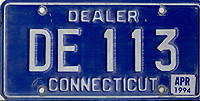 |
|
1994. I believe regular passenger car decals were used starting in 1992 (for the 1994 expirations). They also became 2-year registrations at this time.
|
Anyone have a 1995? I can use one... |
| |
|
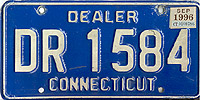 |
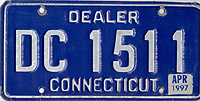 |
| 1996 |
1997
Nearly all 1997 decals were some shade of purple, of the same basic design used for 1995 and 1996. Only a few April ones, like this, were made in the old style in blue on white.
|
| |
|
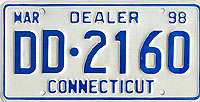 |
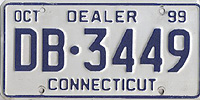 |
1998
The beginning of more changes to dealer plates. Starting with the 1998 expirations, new plates were issued every 2 years. Rather than decals, the expiration date was embossed into the plate.
The dot separator made a permanent comeback. |
1999 |
| |
|
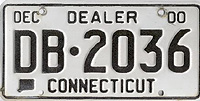 |
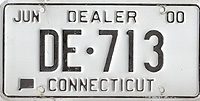 |
2000
The colors are now changed every 2 years.
The little map icon started appearing on dealer plates at this time as well. There were a few dealer plates made for 2000 which didn't have the dot separator. Unlike the 1987 plates above, these were now the exception. |
Another 2000, with the narrow dies used starting for the '02 expirations. This was probably a re-made plate.
|
| |
|
| |
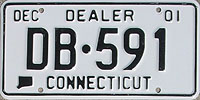 |
| |
2001 |
| |
|
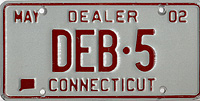 |
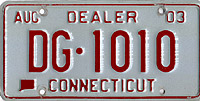 |
|
2002
With the big changes in passenger car plates in 2000, big changes came for all non-passenger types as well. Dealer plates are now fully-reflectorized, on a silver-grey background. A new, skinnier die set is used as well. Personally, I think the old ones were much easier to read.
Starting around this time, larger dealerships could receive plates with a three-letter prefix (issued after DY- was reached). This particular plate was used at an auto auction.
|
2003 |
| |
|
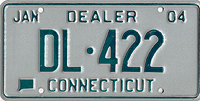 |
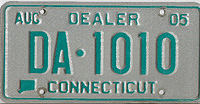 |
| 2004 |
2005 |
| |
|
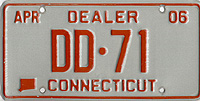 |
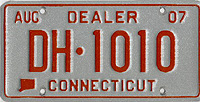 |
| 2006 |
2007 |
| |
|
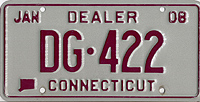 |
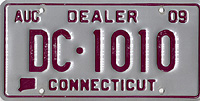 |
2008
|
2009
This plate is made with Avery sheeting for the background. As is often the case with this product, the paint doesn't like to stick to the raised areas. |
| |
|
| Black on silver |
Green on silver |
| 2010, 2011 |
2012, 2013 |
| |
|
| Purple on silver |
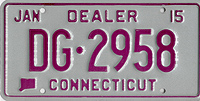 |
| 2014 |
2015 |
| |
|
| Light Blue on silver |
|
| 2016, 2017 |
|
|
|
|
